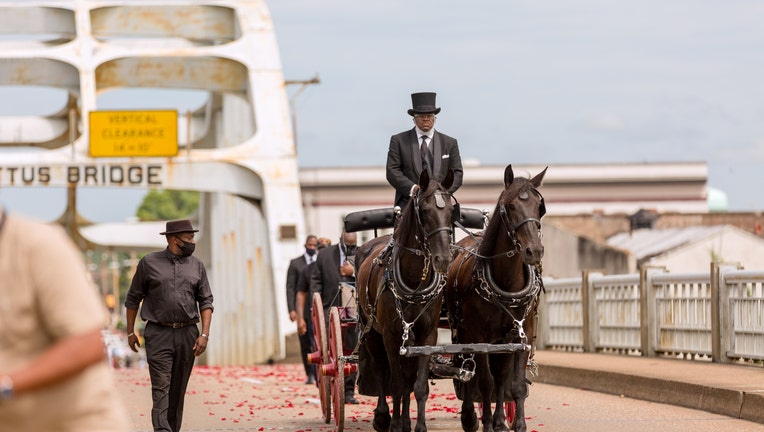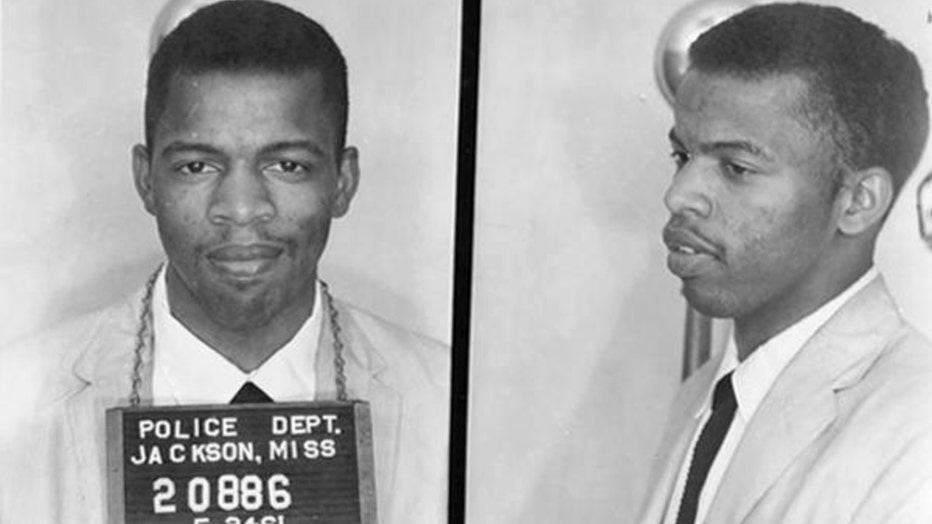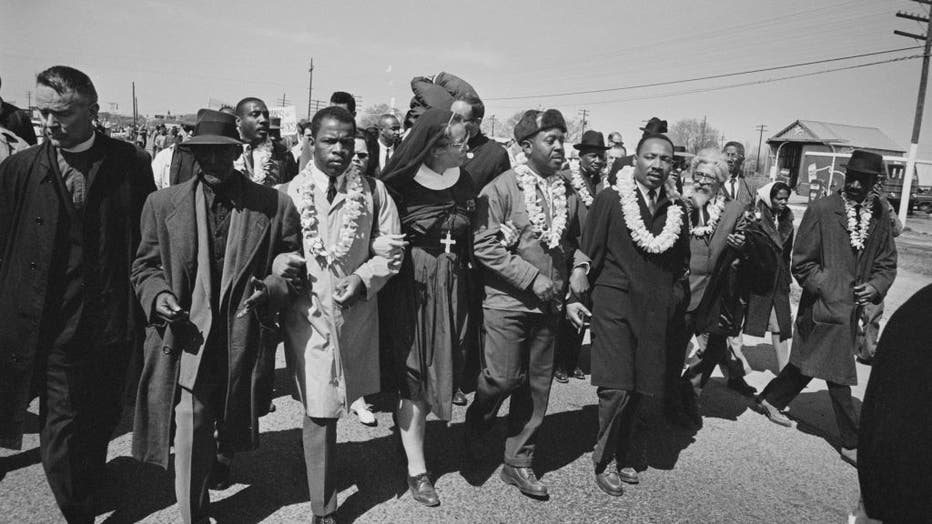Carriage brings body of civil rights legend John Lewis across bridge where police beat him

A horse drawn carriage carrying the body of civil rights icon US Rep. John Lewis (D-GA) crosses the Edmund Pettus Bridge on July 26, 2020 in Selma, Alabama. Lewis's funeral procession continues to follow the Selma to Montgomery National Historic Trai
SELMA, Ala. - The late U.S. Rep. John Lewis crossed the Edmund Pettus Bridge in Selma, Alabama, for the final time Sunday as remembrances continue for the civil rights icon.
The bridge became a landmark in the fight for racial justice when Lewis and other civil rights marchers were beaten there 55 years ago on "Bloody Sunday," a key event that helped galvanize support for the passage of the Voting Rights Act. Lewis returned to Selma each March in commemoration.
Sunday found him crossing alone -- instead of arm-in-arm with civil rights and political leaders -- after his coffin was loaded atop a horse-drawn wagon that retraced the route through Selma from Brown Chapel African Methodist Episcopal Church, where the 1965 march began.
As the black wagon pulled by a team of dark-colored horses approached the bridge, members of the crowd shouted "Thank you, John Lewis!" and "Good trouble!" the phrase Lewis used to describe his tangles with white authorities during the civil rights movement.
JOHN LEWIS FUNERAL TO BE HELD AT EBENEZER BAPTIST CHURCH IN ATLANTA
CIVIL RIGHTS LEADER REV. C.T. LEWIS REMEMBERED AS A GREAT MAN
HIGH SCHOOL NAMED AFTER CONFEDERATE GENERAL WILL NOW BE NAMED AFTER REP. JOHN LEWIS
Some crowd members sang the gospel song "Woke Up This Morning With My Mind Stayed on Jesus." Later, some onlookers sang the civil rights anthem "We Shall Overcome" and other gospel tunes.
Lewis died July 17 at 80, months after he was diagnosed with advanced pancreatic cancer. Lewis served in the U.S. House of Representatives for Georgia's 5th congressional district from 1987 until his death.
The wagon rolled over a carpet of rose petals, pausing atop the bridge over the Alabama River in the summer heat so family members could walk behind it. On the south side of the bridge, where Lewis was beaten by Alabama state troopers in 1965, family members placed red roses that the carriage rolled over, marking the spot where Lewis spilled his blood and suffered a head injury.

A mug shot of civil rights activist and politician John Lewis, following his arrest in Jackson, Mississippi for using a restroom reserved for "White" people during the Freedom Ride demonstration against racial segregation on May 24, 1961. ((Photo by Kypros/Getty Images))
As a military honor guard lifted Lewis' casket from the horse-drawn wagon into an automobile hearse, Alabama state troopers, including some African American ones, saluted Lewis.
Franz and Ellen Hill drove more that four hours from Monroe, Louisiana, to watch the procession.
Franz Hill, 60, said he remembers, as an African American child, watching news footage of Lewis and other civil rights marchers being beaten by law enforcement officers.

Dr Martin Luther King Jr., arm in arm with Reverend Ralph Abernathy, leads marchers as they begin the Selma to Montgomery civil rights march from Brown's Chapel Church in Selma, Alabama, on March 21, 1965; (L-R) an unidentified priest and man, John L ((Photo by William Lovelace/Daily Express/Hulton Archive/Getty Images))
"I had to come back and see John Lewis cross the bridge for the last time," said Hill. "It's funny to see the state troopers here to honor and respect him rather than beat the crap out of him."
Lewis' body was then taken to the Alabama Capitol in the afternoon to lie in repose, retracing the route marchers took in the days after Bloody Sunday to demand justice from Alabama Gov. George Wallace.
Bertha Surles and Edna Goldsmith stood along the highway between Selma and Montgomery to pay their final respects. Both carried signs, reading "Thank you."
"He fought for rights up unto his death," said Surles, 70.
She was in high school on Bloody Sunday and remembered watching the news footage of Lewis being beaten with horror.
"They didn't give up and something good came from it. Still need some improvement, but something good came from it."
"John was willing to sacrifice life so we can have the freedom to vote," said Edna Goldsmith, who was wearing a Black Lives Matter shirt. "We want to see him off with a bang."
Lewis left his family's farm in Pike County, Alabama, in the 1950s to begin the fight against segregation and racial oppression. He received a hero's welcome on his final stop in his home state.
After tracing the route of the completed Selma to Montgomery march, an honor guard carried Lewis' flag-draped casket into the Alabama Capitol, where he will lie in repose.
Peggy Wallace Kennedy, the daughter of former segregationist governor Wallace, was among those in the Capitol for the receiving ceremony, along with most of Alabama's congressional delegation. Alabama Gov. Kay Ivey placed a wreath of flowers shaped like the Alabama flag by the casket. U.S. Rep. Terri Sewell placed a wreath shaped like the American flag.
His family members, many wearing shirts with the phrase "Good Trouble," were led first into the Capitol before the public viewing later in the afternoon. A line of people, some carrying umbrellas for shade, waited under the brutal midday Alabama sun to go inside and pay their respects.
A series of events began Saturday in Lewis' hometown of Troy, Alabama, to pay tribute the late congressman and his legacy. He will lie in state at the U.S. Capitol next week before his private funeral Thursday at Atlanta's historic Ebenezer Baptist Church, which the Rev. Martin Luther King Jr. once led.

